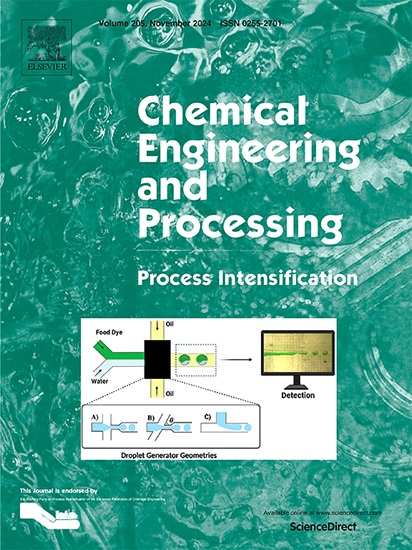An open-source framework for the multi-objective optimization of passive micromixer based on RSM and MOEA/D
IF 3.8
3区 工程技术
Q3 ENERGY & FUELS
Chemical Engineering and Processing - Process Intensification
Pub Date : 2025-04-16
DOI:10.1016/j.cep.2025.110316
引用次数: 0
Abstract
Balancing the mixing index, pressure drop and mixing energy consumption is crucial for enhancing the performance of passive micromixers. In this paper, a T-shaped micromixer scheme integrating cylindrical obstacles and contraction-expansion parts is proposed and the geometric parameters are studied in order to achieve multi-objective optimization. The geometry of the micromixer is optimized by selecting three design variables (L1, L2 and Dcy), where L1 and L2 are used to adjust the changes in the cross section of the flow channel and Dcy controls the diameter of the cylindrical obstacle. For different Reynolds numbers (0.1 and 100), COMSOL simulation and Box-Behnken experiment design are used to evaluate the effects of each design variable on the mixing evaluation indicators. The findings indicate that L2 exerts the most substantial influence on the performance of the micromixer. It can effectively modify the width of the flow channel, thereby optimizing the fluid velocity and concentration gradient, and consequently having a significant impact on mixing evaluation indicators. Regarding multi-objective optimization, the decomposition based multi-objective evolutionary algorithm (MOEA/D) is used to construct the Pareto optimal solution. This algorithm offers a balanced scheme between different mixing evaluation indicators. The experimental results demonstrate that the optimized micromixer can not only enhances the mixing index but also remarkably reduces the pressure drop. It can achieve a complete mixing effect while reducing the pressure drop by nearly 41% compared to the passive micromixer using two-layer serpentine crossing channels when Re = 100, which is especially suitable for microfluidic applications such as biochemical detection. Furthermore, this study makes the MATLAB program source code used in the calculation process publicly available, which provides a strong support for the subsequent research and application.

基于RSM和MOEA/D的无源微混频器多目标优化开源框架
平衡混合指标、压降和混合能耗是提高无源微混合器性能的关键。为了实现多目标优化,提出了一种将圆柱形障碍物与伸缩部件相结合的t型微混合器方案,并对其几何参数进行了研究。通过选取L1、L2和Dcy三个设计变量对微混合器的几何形状进行优化,其中L1和L2用于调节流道截面的变化,Dcy用于控制圆柱形障碍物的直径。对于不同雷诺数(0.1和100),采用COMSOL模拟和Box-Behnken实验设计来评价各设计变量对混合评价指标的影响。研究结果表明,L2对微混合器的性能影响最大。它可以有效地改变流道宽度,从而优化流体速度和浓度梯度,从而对混合评价指标产生显著影响。针对多目标优化问题,采用基于分解的多目标进化算法(MOEA/D)构建Pareto最优解。该算法在不同的混合评价指标之间提供了一种平衡的方案。实验结果表明,优化后的微混合器不仅提高了混合指数,而且显著降低了压降。在Re = 100时,与采用两层蛇形交叉通道的被动式微混合器相比,可实现完全混合效果,同时压降降低近41%,特别适用于生化检测等微流体应用。此外,本研究公开了计算过程中使用的MATLAB程序源代码,为后续的研究和应用提供了有力的支持。
本文章由计算机程序翻译,如有差异,请以英文原文为准。
求助全文
约1分钟内获得全文
求助全文
来源期刊
CiteScore
7.80
自引率
9.30%
发文量
408
审稿时长
49 days
期刊介绍:
Chemical Engineering and Processing: Process Intensification is intended for practicing researchers in industry and academia, working in the field of Process Engineering and related to the subject of Process Intensification.Articles published in the Journal demonstrate how novel discoveries, developments and theories in the field of Process Engineering and in particular Process Intensification may be used for analysis and design of innovative equipment and processing methods with substantially improved sustainability, efficiency and environmental performance.

 求助内容:
求助内容: 应助结果提醒方式:
应助结果提醒方式:


